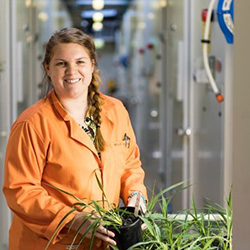
Hannah Osborn
@han_osb321
Last year I had the opportunity to join the Australian Academy of Science for a three month paid internship with the science policy team. I’m currently a third year PhD candidate at the Australian National University and CSIRO Agriculture studying ways to improve photosynthesis with the ultimate goal of increasing yield in important food crops.
Despite my love for science research, halfway through my PhD I realised that an academic research career was not quite right for me. After years of having the undergrad, PhD, post doc, lab leader pathway instilled in me, I found it difficult to know what else a PhD would be valuable for [Ed. Lots! We’re working on ways to remind EMCRs of this]. Since identifying this, I’ve tried hard to expand my skill set beyond traditional lab techniques and have volunteered for events such as Science meets Parliament where I could practise communicating science with those in politics. One of the key reasons I applied for the internship was to gain an insight into the public policy field and develop firsthand experience in science policy.
During the internship my primary task was writing a discussion paper entitled ‘Synthetic gene drives in Australia: implications of emerging technology’. Gene drives are a form of biased inheritance in which a gene can spread throughout a population at a rate higher than traditionally expected. Significant advances in genetic and molecular tools for genome editing have brought synthetic gene drive technology within the reach of many more researchers, and research has accelerated greatly in recent years.
An idealised illustration of Mendelian versus gene drive inheritance rates. Through standard Mendelian inheritance (left), offspring have a 50% chance of inheriting a modified gene carried by one of their parents. With a gene drive mechanism (right) the modified genes are eventually inherited by 100% of the offspring, allowing the gene to spread rapidly through the population. Images from Nova: science for curious minds.
As with many new technologies, the potential applications and benefits are far reaching, as are the potential impacts—both intended and unintended—on public health, conservation and ecology. It was a great opportunity to be involved with the Academy to write this document which is intended to inform both the government and community of gene drive technology. We wrote the discussion paper together with members of a working group with expertise in relevant fields, and we also consulted the general public and key stakeholders. Overall, the paper discusses synthetic gene drives in an Australian context and highlights the potential benefits and possible environmental, social, economic and governance issues. We’re expecting the paper to be released in early May.
This was a really exciting project to work on, especially since research in this field is moving so rapidly and there are lots of international discussions occurring. The internship was a valuable experience for me and I thoroughly enjoyed being in an organisation that was excited and positive about science. It was great to have the opportunity to work independently and try my hand at policy writing—all the while being supported and guided by the science policy team to create a tangible and relevant end product. I learned a lot about the policy environment and observed some of the challenges science policy faces.
Personally, the internship gave me confidence that a PhD is actually valued outside of academia and that I would enjoy and do well in a science policy environment. I would encourage anyone interested in science communication and learning how public policy works to consider a policy internship with the Australian Academy of Science. [Ed. Keep an eye on the EMCR Forum e-updates—we will advertise future opportunities as they arise.]

© 2025 Australian Academy of Science